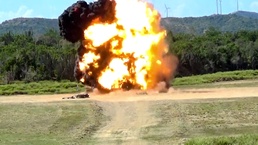
GUANTANAMO BAY, Cuba - Three recreational divers headed to Ferry Landing Beach looking to bag some lionfish and lobster, but got much more than they bargained for recently at U.S. Naval Station Guantanamo Bay, Cuba, on Nov 7.
Upon entering the water, they noticed the poor visibility. Regardless, the group decided to continue. It wasn’t long before the divers decided to call it quits, due to the ocean conditions, and headed back to shore. While returning, one of the divers noticed an unknown square-shaped object. He grew curious and decided to take a closer look.
“When you are diving, you look for something different. Not far off of shore, I noticed something that looked like a bomb,” said John Imhoff, the officer in charge with the Office of Military Commissions South.
Seeing the object, Imhoff called one of his dive buddies, Navy Capt. Alan Redmon, the Joint Task Force director of engineering, over to look. Once the two assessed the object they knew they had to report it. Redmon, a former Navy scuba diver with Underwater Construction Team One and a Professional Association of Diver Instructors-certified master scuba diver, then tied a marker approximate to the area of the unexploded ordnance.
“When you’re marking something like that, you don’t want to mark it directly, that could be dangerous,” said Imhoff. “Instead mark an area nearby so it is close enough but not too close.”
While Redmon and Imhoff were marking the area, another member of the dive group, Navy Capt. Christopher Scholl, the Joint Task Force director of public affairs, called port operations to report their suspicious finding.
Approximately five minutes later, the authorities showed up, shut the area down and Redmon gave them a description of what the object looked like, he said.
Naval Station Dispatch was notified, who then contacted Emergency Services, the Weapons Department, and Navy divers, said Navy Lt. Jeff Crabtree, the base weapons officer at the Weapons Department.
A mandatory UXO cordon was set and Navy divers coordinated with the Weapons Department to properly execute a reconnaissance of the device. An Explosive Ordnance Disposal Mobile Unit was contacted to review collected reconnaissance data and arrange an emergency response. After the Navy divers and members of the Weapons Department deemed the UXO safe for transport, they carefully extracted the 25-pound MK76 Practice Bomb from the water where explosives ordnance disposal technicians then transported it to the EOD range.
Additionally, more than 2,000 units of unserviceable joint service munitions were simultaneously delivered by Weapons Department to the EOD range for disposal, said Crabtree.
In two separate demolition shots, a combined net explosive weight of more than 100 pounds was detonated to destroy the UXO and all unserviceable ordnance. Multiple satchel charges, containing more
than a dozen sticks of C4 explosives each, were used in the successful disposal of these items.
Due to the divers’ careful and tactful steps to identify, mark and alert authorities the UXO was properly removed and disposed of.
“UXOs are reported an average of every two to three months,” said Crabtree.
If you do come across an UXO when snorkeling or diving, you should know how to handle it, said Imhoff. The first step is to recognize when you have encountered a potential UXO. Look for something that’s out of place and not of the usual in terms of color or shape. Do not touch, move or disturb the potential UXO. Quickly note the exact location and carefully evacuate the area and call 911.
For more information concerning the identification, marking and reporting possible UXOs contact the Weapons Department at ext. 4574.